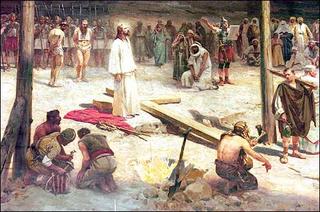Religious Painting Gets Extreme Makeover
"In 1894, Ignace Paderewski, noted musician, statesman, and Premier of Poland conceived a painting of the Crucifixion of Christ and inspired fellow countryman Jan Styka with the idea. For two years, the artist studied and sketched in the Holy Land-- and on his way back to Poland, Styka knelt in Rome before Pope Leo the XIII to have his palette blessed. The gigantic canvas, made to order, awaited his return.
The first exhibition in Warsaw was marked by all Europe as the great religious and artistic event of the century. In 1904, Styka brought the painting to America hoping to see it displayed at the St. Louis Exposition, but no suitable place was found. Pressed with obligations and expenses, he was forced to return to Poland without his masterpiece. He never saw it again. ..."
Later "the painting was discovered in a storage room in 1944, wrapped around a telephone pole, below an opera house in Chicago ...
The religious tones of Styka's work Christ alone before the time of his execution, Roman soldiers keeping mourners away, St. John comforting the Virgin Mary, shepherds and townspeople watching and the fact that it was a panaroma meant to be seen in a semicircle to tell the story, was common for the period, said Louise Lewis, professor emeritus and director for the California State University, Northridge Art Galleries.
"Panoramas were indeed very popular at that time," Lewis said. "They were [an early] version of moving pictures. Artists rolled them open. They were popular in entertainment in America [and Europe].""
Sources: Susan Abrams Massive Painting Being Restored LA Daily
(via ArtsJournal.com) August 2, 2005 and Forestlawn.com

"Cruxifiction" by Polish painter Jan Styka (45 feet by 195 feet)
Styka (1858 - 1925) was born in what was Lemberg,
Austro-Hungary, but, Lwow, Poland, when he died; and is now
Lviv, Ukraine. The city was over one-third Jewish on
September 1, 1939. After WWII (Russia's and Ukraine's Great
Patriotic War), many Jews who survived the Holocaust or who
had fought as partisans made Lvov, the Soviet Union (until 1991)
their home.
The first exhibition in Warsaw was marked by all Europe as the great religious and artistic event of the century. In 1904, Styka brought the painting to America hoping to see it displayed at the St. Louis Exposition, but no suitable place was found. Pressed with obligations and expenses, he was forced to return to Poland without his masterpiece. He never saw it again. ..."
Later "the painting was discovered in a storage room in 1944, wrapped around a telephone pole, below an opera house in Chicago ...
The religious tones of Styka's work Christ alone before the time of his execution, Roman soldiers keeping mourners away, St. John comforting the Virgin Mary, shepherds and townspeople watching and the fact that it was a panaroma meant to be seen in a semicircle to tell the story, was common for the period, said Louise Lewis, professor emeritus and director for the California State University, Northridge Art Galleries.
"Panoramas were indeed very popular at that time," Lewis said. "They were [an early] version of moving pictures. Artists rolled them open. They were popular in entertainment in America [and Europe].""
Sources: Susan Abrams Massive Painting Being Restored LA Daily
(via ArtsJournal.com) August 2, 2005 and Forestlawn.com

"Cruxifiction" by Polish painter Jan Styka (45 feet by 195 feet)
Styka (1858 - 1925) was born in what was Lemberg,
Austro-Hungary, but, Lwow, Poland, when he died; and is now
Lviv, Ukraine. The city was over one-third Jewish on
September 1, 1939. After WWII (Russia's and Ukraine's Great
Patriotic War), many Jews who survived the Holocaust or who
had fought as partisans made Lvov, the Soviet Union (until 1991)
their home.


0 Comments:
Post a Comment
<< Home